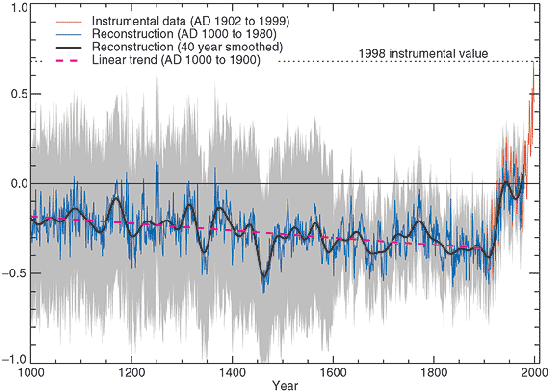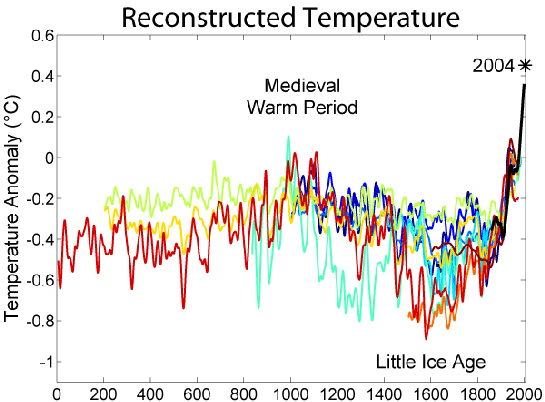(Part of the How to Talk to a Global Warming Skeptic guide)
Objection: The Hockey Stick graph — the foundation of global warming theory — has been shown to be scientifically invalid, perhaps even a fraud.

Answer: The first order of business here is to correct the mischaracterization of this single paleoclimate study as the “foundation” of global warming theory.
What’s going on today is understood via study of today’s data and today’s best scientific theories. Reconstructions of past temperatures are about, well, the past. Study of the past can be informative for scientists, but it is not explanatory of the present nor is it predictive of the future. The scientific foundation of global warming theory contains much more than a few tree-rings and the temperature during the Medieval Warm Period.
RealClimate has an interesting article about what it would mean for today’s climate theories if the MWP had indeed been warmer than today.
Now, about that pesky bit of sporting equipment …
The infamous “Hockey Stick” graph was featured prominently in the IPCC TAR Summary for Policymakers. It was important in that it cast serious doubt on the notion both of a global Medieval Warm Period warmer than the 20th century and of a global Little Ice Age, both long-time (cautiously) accepted features of the last 1,000 years of climate history. It seems these periods were regional, not globally synchronized — though the LIA seems to have been more widely experienced.
This caused quite an uproar in the skeptic community, not least because of its visual efficacy. Two Canadians, an economist and a petroleum geologist, took it upon themselves to verify this proxy reconstruction by getting the data and examining the methodology for themselves. They found errors in the description published in Nature of the data used — errors that prevented them from duplicating the study. Mann et al., the hockey stick’s creators, published a correction in Nature, noting where the description did not match what had actually been done. The Canadians, McIntyre and McKitrick, then published a paper purporting to uncover serious methodological flaws and problems with data sets used.
Everything from this point on is hotly disputed and highly technical.
All the claims made by M&M have been rebutted in detail by many other climatologists; M&M insist they are completely in error. All of it fits nicely with the expectations of both sides of the global warming issue, both the conspiracy theorists and the champions of peer review.
The rebuttals have been objected to and the objections denied and the denials rejected. The specific issues are highly technical and require considerable time and energy to fully understand. Steve McIntyre has a website devoted to his continued probe of this study and Michael Mann is a contributor to RealClimate, which consumes considerable web space refuting his attacks.
In short, M&M raise many specific and technical objections, and climate scientists seem pretty unified in denying the charges. To my knowledge, the worst indictment from the climate science community came from a study led by Hans Von Storch that concluded M&M was right about a particular criticism of methodology, but that correcting it did not change the study results.
If you want to evaluate the issue for yourself, and do it fairly, you must read the copious material at the sites mentioned above. You must also be prepared to dig into dendrochronology and statistical analysis.
Where does that leave the rest of us — you know, the ones with lives?
I confess immediately that the technical issues are over my head. I don’t know PCA from R^2 from a hole in the ground. But the most critical point to remember, if you are concerned about this for its impact on the validity of AGW theory, is that the fight is over a single study, published eight years ago, focused on paleoclimate. It verges on historical minutia. If you feel the study may be tainted, simply discard it.
The fact is, there are dozens of other temperature reconstructions. They tend to show more variability than the original hockey stick (their sticks are not as straight), but they all support the general conclusions the IPCC TAR presented in 2001: late 20th century warming is anomalous in the last one or two thousand years, and the 1990s were likely warmer than any other time in that period.
Here’s a superimposition of numerous global, hemispheric, and regional temperature reconstructions for the last 2,000 years, together with an average. References can be found at the bottom of this Global Warming Art link. Regional variations are of course greater than global, so don’t be surprised by how wavy some of the lines are.

(Disclosure: one of the reconstructions used in that page is by the same team that did the infamous hockey stick — but it is not the same study. To the best of my knowledge, M&M have claimed no problems with that one, though they have expressed some concerns that span the entire field of dendrochronology).
Does the 20th century stand out?
Recently the National Academy of Science in the U.S. did a report on the hockey stick study and found it “plausible,” though more uncertain the farther back in time it went. But then, true to form for this debate, another report commissioned by another Senate committee came out right afterwards and condemned it. Sigh.
I have read as much about this controversy as I ever intend to, and come to the firm conviction that I don’t have the technical background and/or time required to make a scientific judgment on the issue one way or another. I suspect 95% of the people arguing about this have chosen their position ideologically and won’t be able to explain the merits of the various arguments.
So while in my mind MBH are in no way guilty of fraud or incompetence (many of the accusations do go that far), judgment of their research must be approached in reverse: given reason to doubt, I will reject it until it is proven to me that the criticisms are invalid. I can’t decide for myself until I devote the required time to both the statistical background and the technical details of M&M vs MBH98. That isn’t going to happen!
So where does that leave me and (I suspect) most of you?
Well, it leaves me with dozens of other proxy reconstructions, some by the same team or involving some of its members, some by completely different people, some using tree rings, some using corals, some using stalagmites, some using borehole measurements — all supporting the same general conclusion. That general conclusion is what’s important to me, not whether or not one Bristlecone pine was or was not included correctly in a single eight-year-old study.
Although each of the temperature reconstructions are different (due to differing calibration methods and data used), they all show some similar patterns of temperature change over the last several centuries. Most striking is the fact that each record reveals that the 20th century is the warmest of the entire record, and that warming was most dramatic after 1920.
End of story.
To conclude where I started: study of the past can be informative for scientists, but it is not explanatory of the present, nor is it predictive of the future. The science of global warming is rooted in what we know about today.
Now, can we all get off of the hockey rink and back into the lab?


